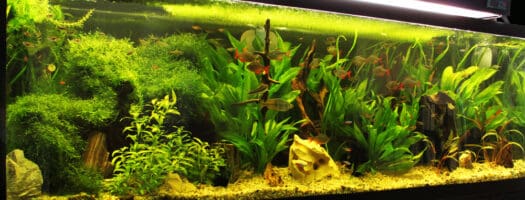The 8 Best Ferret Harnesses to Buy in 2025
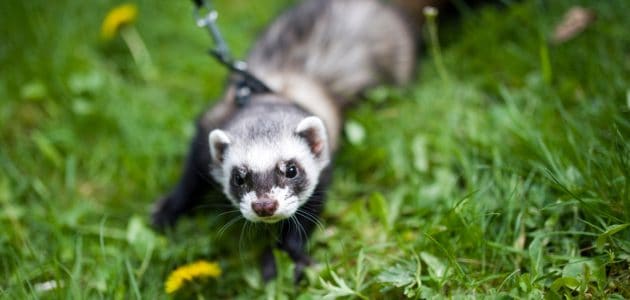
As every ferret owner knows, each little ball of fur is unique and has its own personality. Some are content lying in their hammocks all day or rolling a ball across the floor for hours at a time, while some crave other forms of excitement.
Most ferrets need a variety of enrichment activities, and for many adventurous critters, that can mean taking trips outside. Ferrets are quick, wily, and prone to escape, so it’s necessary for them to be walked on a harness whenever they’re outside. But deciding which ferret harness is best isn’t exactly a simple proposition.
- Most Important Factors in Choosing a Ferret Harness
- Top 8 Best Ferret Harnesses 2025
- 1. Best Overall Ferret Harness: Kaytee Comfort Harness & Stretchy Leash
- 2. Best Premium Ferret Harness: Marshall Ferret Harness and Lead
- 3. Best Budget Ferret Harness: Ware Manufacturing Walk-N-Vest Pet Harness
- 4. Most Stylish Ferret Harness: RYPET Small Animal Harness
- 5. Best Multi-Pet Ferret Harness: GAUTERF Kitten and Puppy Universal Harness
- 6. Cutest Ferret Harness: Margelo Ferret Harness and Leash
- 7. Best Cheap Mesh Ferret Harness: PERSUPER Soft Mesh Small Pet Harness
- 8. Best Harness for Small Ferrets: Sandia Pet Products Ferret Harness
- Complete Guide to Ferret Harnesses
- Ferret Harness FAQs
- Final Thoughts
Most Important Factors in Choosing a Ferret Harness
Safely walking a ferret outside is more complex than simply finding a collar and a leash. Ferrets’ unique skeletal structure means that they can be injured if too much pressure is placed on their long necks, so for ferret owners whose beloved furballs love being outside, a harness is a necessary piece of equipment. Let’s take a closer look at what you need to know about ferret harnesses.
Harness Type
There are two styles of harness that are generally considered the safest for ferrets: H-style and vest harnesses. Neither is inherently better than the other, but in our research, vest-type harnesses were more widely available, though that type tends not to be designed with ferrets in mind.
However, they also allow for a bit more creative expression given that they cover more of the body, though more material isn’t necessarily good (we’ll tell you why here).
There’s a bit more to it than that, though, so if you’re interested in the details be sure to read more about them below.
Safety
Ensuring that your ferret is safe and secure before you head outside is crucial. These are wily, quick-moving critters who can be difficult to catch, particularly outside. So, ensuring you’ll be able to find a harness that is comfortable for the ferret while being as secure as possible is vital.
Many harnesses come with safety bells (like this stylish option or this affordable alternative), and for those that don’t, you could consider adding one.
Material
Typically, only a few material options are available in harnesses that are designed for ferrets or ones that will fit ferrets. There are a few main considerations when it comes to materials: comfort, safety, and security. Among the most popular materials are super-strong nylon, breathable mesh, comfortable cotton, and elastic for a great fit.
Price
Perhaps the best news about ferret harnesses is that they are quite inexpensive. This is especially helpful since it’s likely that you’ll need to try at least a couple of harnesses to see what your ferret likes, as well as what will fit best. All the harnesses we reviewed were cheaper than $15.
Top 8 Best Ferret Harnesses 2025
1. Best Overall Ferret Harness: Kaytee Comfort Harness & Stretchy Leash
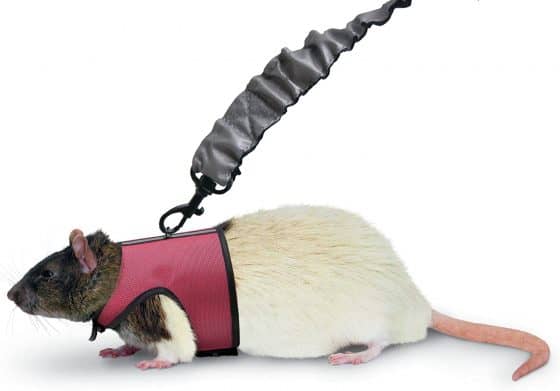
Editor’s Rating:
Why we like it: A perfect balance of price and comfort, the Kaytee Comfort Harness & Stretchy Leash make it easy to safely secure your ferret and the unique leash design helps keep your ferret close by.
At a Glance:
- Type: Vest
- Made for ferrets? No; designed for small animals
- Material: Mesh fabric
- Size(s): S, M, L
Comfort
The loop for this vest-type harness will hit in the mid-back for a typical adult ferret, while the stretchy fabric will give the ferret a nice, warm hug.
Ease of Use
Strapping your ferret in with the adjustable Velcro straps is easy, and the included unique stretchy leash keeps your ferret close by while ensuring it’s not being jerked back if it ventures too far out.
Safety
In addition to the Velcro straps, a snap buckle keeps the ferret tucked in tight while still allowing a good range of motion and freedom. The vest design makes it easy to see at a glance so you can be sure the animal is still safely attached to the leash.
Good to Know
While this harness was designed for multiple types of small animals, it comes in a variety of sizes, though it’s likely the small size will be right for most ferrets. Still, for larger ferrets, the medium size may be better, while especially small ferrets, such as young females, may not find one that fits at all—instead, try something like the ferret-specific Sandia Pet Products Ferret Harness.
Pros
- Soft, comfortable vest
- Double closure methods (Velcro and snap buckle)
- Stretchy leash
- Variety of sizes
Cons
- Relatively expensive
- Smallest size may not be small enough for tiny ferrets
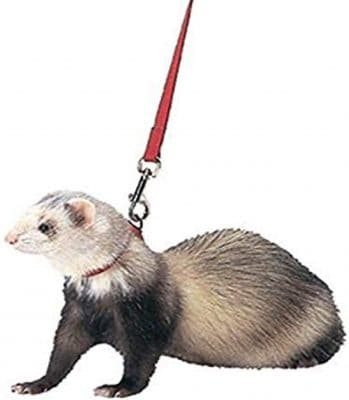
Editor’s Rating:
Why we like it: It’s a no-frills option, but it’s been designed especially for ferrets by Marshall, which is the industry leader in ferret products. The simple H-style construction and quality make this harness ideal for owners willing to spend a bit more.
At a Glance:
- Type: Harness
- Made for ferrets? Yes
- Material: Nylon straps
- Size(s): Adjustable
Comfort
Because the Marshall H-style harness was designed specifically to fit the anatomy of a ferret, it will be perfectly comfortable for most ferrets. It’s also adjustable, so if your ferret strains against the straps (or, worse, gets free), it’s simple to tighten them up. But this is an H-type harness, so it lacks some of the creature comforts present in most vest-style harnesses.
Ease of Use
Quick-snap buckles and easily adjusted straps make this easy to put on and adjust, and it’s easy to take off once you’re back from your walk. The included leash is not adjustable, though.
Safety
The two adjustable buckles help ensure your ferret is securely attached to the harness, and with a product made specifically for ferrets, you can be sure it’s been tested against the most extreme wigglers. It does lack a safe bell, though it may be possible to attach one.
Good to Know
A 48-inch leash is included in a color that matches each harness, with several color options. This does allow for some personal expression, though other options on the list are better for that (if it’s your thing).
Pros
- Designed specifically for ferrets
- Simple H-type construction
- Strong nylon straps and double buckles ensure a safe fit
- Comes with leash
Cons
- No size options
- Included leash is not adjustable
3. Best Budget Ferret Harness: Ware Manufacturing Walk-N-Vest Pet Harness
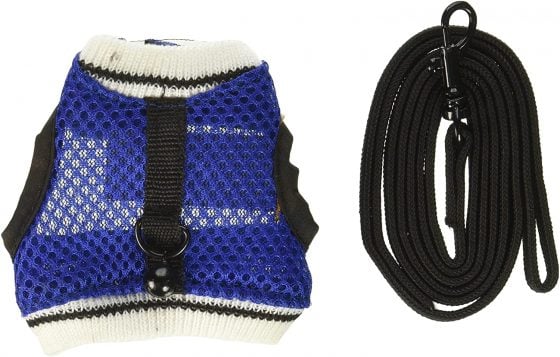
Editor’s Rating:
Why we like it: Ware Manufacturing’s Nylon Walk-n-Vest Pet Harness is the cheapest of the products that made our list, but that doesn’t mean it’s short on quality — or style. The cute design will be sure to attract attention wherever you and your ferret venture.
At a Glance:
- Type: Vest
- Made for ferrets? No; designed for small animals
- Material: Nylon mesh
- Size(s): S, M, L, XL
Comfort
The durable nylon mesh of this vest provides a breathable fabric that can help keep your ferret’s body temperature at a safe level.
Ease of Use
Dual fasteners (Velcro and clip buckles) are easy to take on and off, though the lack of adjustability may mean that you’ll have a tough time getting a customized fit.
Safety
This harness was designed for many types of small animals, which means it wasn’t made with ferret bodies in mind. That said, for those who are the right size (ideally young and/or small ferrets), the dual closure and durable nylon will help keep a ferret safe and having fun. If your ferret won’t fit in this harness, the Margelo Ferret Harness and Leash offers similar features in a more ferret-friendly fit.
An included safety bell can give you extra peace of mind. With ferret harnesses, safety bells vary from the collar-style bells many people place on their cats. When your ferret’s harness has a safety bell, the bell lets you know everything is good; it’s when the noise stops that you need to worry because it indicates the ferret may not be there anymore.
Good to Know
Ware Manufacturing’s mesh vest harness comes in several size options, and small is probably the only one that would fit a ferret. The included safety bell is ideal for ferrets who may be prone to escape.
Pros
- Inexpensive
- Cute and sporty style
- Dual closure (Velcro and buckles)
- Includes leash and safety bell
Cons
- No ability to adjust fit
- Even smallest size may not be small enough
4. Most Stylish Ferret Harness: RYPET Small Animal Harness
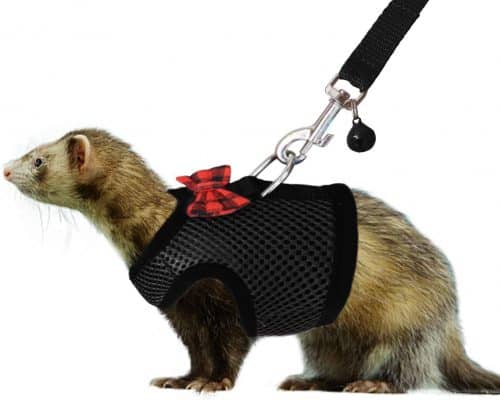
Editor’s Rating:
Why we like it: It’s just stinkin’ cute. Each soft mesh vest-style harness is complemented on the back with a black-and-red checkered bow tie that helps you and your ferret step out in style.
At a Glance:
- Type: Vest
- Made for ferrets? No; designed for multiple small animals
- Material: Mesh fabric
- Size(s): S, M, L
Comfort
The breathable mesh material used to construct the vest-style harness has a ring that should hit most ferrets in the mid-back, which is ideal for walking.
Ease of Use
Getting the harness on and off again is quite easy, with two Velcro straps connecting, one in front of the forelegs and one around the torso. This does lack the dual-style latches that many other options provide, so be sure to walk your ferret a lot inside before taking this outside to ensure a snug and secure fit.
Safety
A safety bell is included, though it comes attached to the leash rather than the harness, which may create a slightly annoying obstacle to latching the leash onto the harness. Also, as mentioned, Velcro is the only fastener used, which can wear out over time.
Good to Know
Three color options (black, gray, and red) all have the same black-and-red checkered bow tie, so while you can express some personality, the options are somewhat limited. Given the nature of Velcro, the harness is somewhat adjustable, but not to the extent that some others are.
Pros
- Very cute style
- Soft mesh fabric
- Includes leash and safety bell
- Inexpensive
Cons
- Double closure, but both are made of Velcro
- Not much adjustability
5. Best Multi-Pet Ferret Harness: GAUTERF Kitten and Puppy Universal Harness
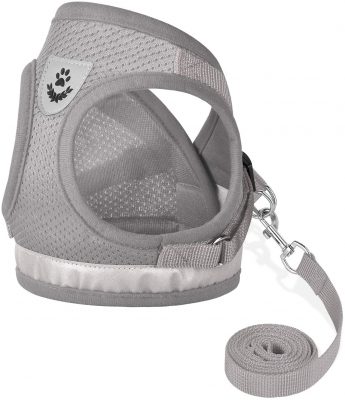
Editor’s Rating:
Why we like it: The soft corduroy mesh material is very comfortable for ferrets, and it can also be used for other small pets as well, making it perfect for pet owners who may need to use one harness for multiple pets.
At a Glance:
- Type: Vest
- Made for ferrets? No; designed for cats and dogs
- Material: Padded mesh
- Size(s): XXS-XL (only XXS will fit typical ferrets)
Comfort
The soft mesh fabric is breathable and comfortable against the ferret’s body, and two adjustable straps make it possible to customize the fit so it’s just right.
Ease of Use
This harness may take a couple of tries to successfully get around your ferret. That’s because the only clasp is in the back where the leash latches on. For especially wriggly ferrets, you probably will need to move quickly in order to get it buckled.
Safety
A Velcro patch is layered under the buckle fastener to enhance security and safety, and a reflective strip at the bottom of the vest makes low-light walks a little safer, though there are other reasons you may want to avoid these, depending on your ferret. The harness does not come with a safety bell.
Good to Know
Several size options are available, but for the typical ferret, the only size that will fit is XXS, and because this product was designed for cats and dogs, the leash latch hook in back may be in an odd spot on some ferrets. Several color options are available, and the harness comes with a matching leash, though that’s not adjustable.
Pros
- Soft, breathable mesh fabric
- Multiple avenues to adjust fit
- Reflective strip helps make walking in low light safer
- Can fit multiple types of animals
Cons
- Somewhat complicated to put on
- Likely only one size that will fit a ferret
6. Cutest Ferret Harness: Margelo Ferret Harness and Leash

Editor’s Rating:
Why we like it: Margelo’s angel wings ferret harness turns the cuteness dial all the way up to 11, and it’s inexpensive enough that if your ferret hates it, you aren’t out much cash.
At a Glance:
- Type: Vest
- Made for ferrets? Yes
- Material: Cotton
- Size(s): Adjustable
Comfort
The slimmest vest-type harness we looked at, Margelo’s harness is constructed of breathable cotton fabric to which cotton angel’s wings are attached. Two clasp buckles connect in the shoulder area and allow for adjustability, so it could be said that this harness is a hybrid between vest and H-style harnesses.
Ease of Use
Rather than clasping in the back, the buckles that secure this harness clasp on the side, near the ferret’s shoulder. This does take some getting used to, and it’s unlike most other types of animal harnesses.
Safety
A safety bell is included, and the pair of clasps provide adequate security, and because these are designed for ferrets, all the elements hit the animal in the ideal spots.
Good to Know
Two fabric patterns are available, and both include attached white angel’s wings. That embellishment may make it more difficult to train your ferret to use this harness, though if they’ve never been exposed to any others, they probably won’t know any different.
Pros
- Off-the-charts cuteness level
- Pair of buckle clasps
- Included leash and safety bell
- Inexpensive
Cons
- Buckles hit in slightly odd area
- Only one size option
7. Best Cheap Mesh Ferret Harness: PERSUPER Soft Mesh Small Pet Harness
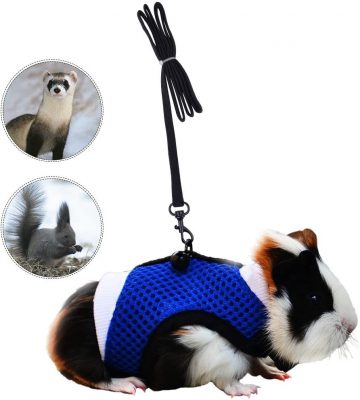
Editor’s Rating:
Why we like it: PERSUPER’s mesh vest is the cheapest vest-style harness among those we looked at, but it’s not light on style, with a fun, sporty look.
At a Glance:
- Type: Vest
- Made for ferrets? No; designed for many small animals
- Material: Padded nylon mesh
- Size(s): Adjustable
Comfort
The padded nylon mesh fabric this harness is made of is light and breathable, while keeping the ferret feeling snug inside.
Ease of Use
PERSUPER’s harness clasps and latches on the underside, which may take some practice with very fussy ferrets. The straps attach with both Velcro, which is adjustable, and buckle clasps.
Safety
The dual-closure straps help ensure your ferret is securely buckled in before you set out into the great big world, and a safety bell further enhances security.
Good to Know
This harness wasn’t made exclusively for ferrets, so some of the way it functions (such as a latch being on the underside of the belly) are a bit strange given what we know about how rascally ferrets can be.
Pros
- Inexpensive
- Soft mesh fabric
- Includes leash and safety bell
- Dual closure clasps
Cons
- One buckle hits on underside of torso
- Not made for ferrets
8. Best Harness for Small Ferrets: Sandia Pet Products Ferret Harness
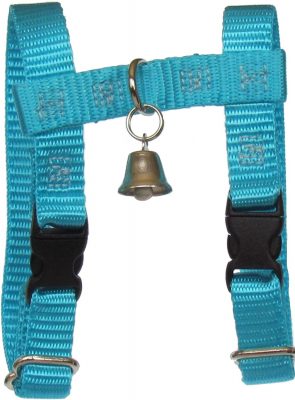
Editor’s Rating:
Why we like it: Sandia’s H-style ferret harness comes with few frills, but the included safety bell can help you keep track of a ferret of any size while on walks.
At a Glance:
- Type: Harness
- Made for ferrets? Yes
- Material: Nylon straps
- Size(s): Adjustable
Comfort
The adjustable nylon straps and buckles are designed to properly fit to the body of a ferret no matter how small they are, which means all the items should hit the animal in areas that make it comfortable to wear for long periods.
Ease of Use
The buckle clasps connect on either side of the forelegs, which is standard for H-style harnesses. Adjustable straps can help customize the fit.
Safety
An included safety bell adds to the security of double buckle clasp fasteners, though no leash is included.
Good to Know
For the money, this harness is on the high side for what’s included, as it doesn’t come with a leash. But several color options are available, and it includes a safety bell, though no other frills.
Pros
- Simple H-style construction
- Sturdy nylon straps ensure security
- Safety bell included
- Made specifically for ferrets
Cons
- Slightly pricey for few included extras
- Doesn’t come with leash
Complete Guide to Ferret Harnesses
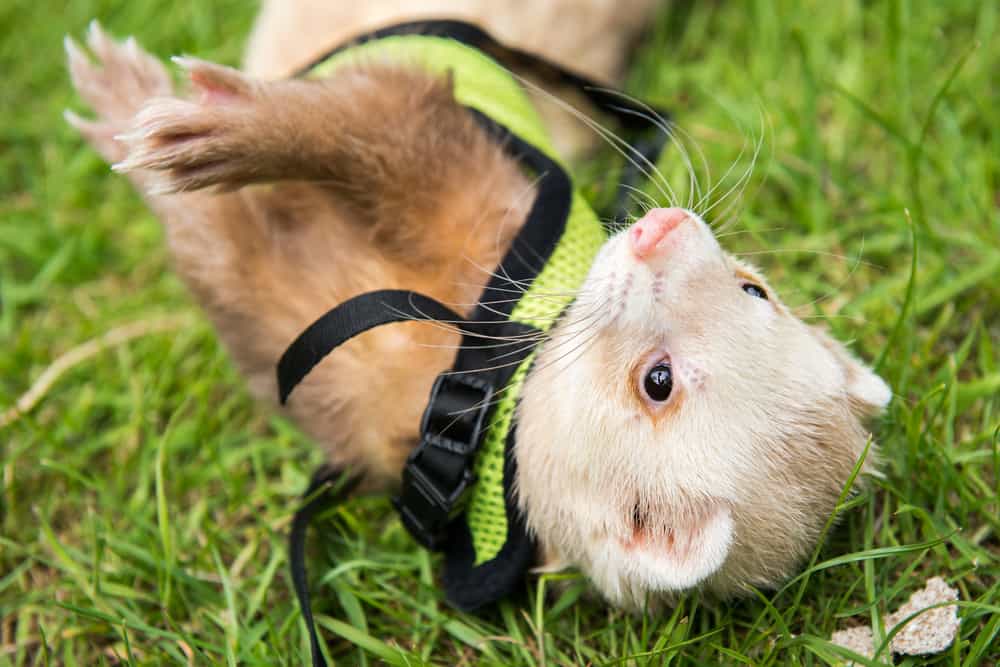
Ferret harnesses are quite simple products, but as with anything else we buy for our fuzzballs, there are reasons why you might favor one type over another.
Types of Ferret Harnesses
All the products we reviewed fit into one of two types — H-style and vest. Which option is right for you and your ferret will definitely be the biggest decision you make. Learning more about their similarities and differences can be helpful.
H-Style
These types of harnesses (like this one) are so named because when looking at them from the side, the loops and connectors form the shape of the letter H. One loop goes around the neck, while the second goes behind the front legs and around the torso. These usually have little material and simply consist of the straps and buckles.
Vest
Using a similar design to the H-style harness, vest harnesses like the Kaytee Comfort Harness & Stretchy Leash wrap around the neck and behind the front legs, usually connecting with Velcro, but they are made with mesh or fabric that forms a vest when placed on the ferret.
In both cases, the harness fits around the neck and torso of the critter and allows a leash to be connected to the back. This serves two key functions. First, it more evenly distributes pressure on the neck, shoulders, and torso; if ferrets are walked only using a collar and leash, all pressure is placed on the neck. Second, if harnesses are properly fitted, they keep ferrets safe and secure when outside.
There’s one other type of harness that is on the market, but it’s generally not as comfortable for ferrets and may be less secure. The 8-shape harness is so named because it’s made of a single strand or piece of rope that is wrapped around the ferret’s body, forming a figure 8. This is a popular method for ferret owners who may want to make their own harness, which is a fairly simple process.
Regardless of the style you decide on, testing the harness and leash out in the house before taking your ferret outside is crucial so you can be sure your fuzzy friend won’t escape. Check out some tips on that.
Proper Harness Fit
Ferrets are small, sleek animals, with adult females weighing only about 1.5 pounds on average and adult males averaging about 3 pounds. They also are extremely fuzzy, and these coats can make them seem larger than they are.
So it’s important that before choosing a harness that you physically handle your ferret, measuring their torso circumference if you can, so you can get a sense of their girth.
This can help you eliminate guesswork when buying a harness, which could save you from having to return something that won’t fit.
A proper-fitting ferret harness should be snug but not tight to the animal’s body. Pay special attention to how it fits around the neck, as that’s an especially sensitive area. You should be able to get your pinky finger under the harness. If it’s a struggle, the harness is too tight. If it’s too easy, or if you could fit more than one finger’s width under the harness, then it’s too loose.
Generally, harnesses that are made explicitly for ferrets will give you a better chance of finding one that fits your pet. There are some exceptions, and even harnesses made for cats and dogs could fit the bill.
Safety Considerations
Anybody who’s ever tried to ferret-proof a home knows that these little guys are masters of finding a tiny gap and exploiting it. They may use their claws or teeth to create openings, or may spin around like mad, flailing against obstacles until they get their way.
Ferrets’ claws don’t retract like cat claws, so it’s important to make sure that your ferret can’t get their claws stuck on any material in the harness, such as wide-woven mesh or nylon seams.
Another major issue with walking ferrets doesn’t have anything to do with harnesses but rather with walking a ferret in the first place. Unlike dogs, ferrets can’t handle long walks. A typical ferret will be exhausted after walking for 15-20 minutes, and these tiny critters are highly sensitive to temperature extremes.
So, an ideal walk for a ferret will be when it’s between 55 and 75 degrees in an open, grassy area away from bushes or low trees where a ferret might find an interesting smell and try to dig their way to it.
Also, while ferrets can see in the dark, their night vision isn’t as good as a cat’s or a dog’s, so it’s probably best to avoid walking after dusk.
Training a Ferret to Use a Harness
All animals need to be trained to use a harness, but ferrets may require especially patient training. Other animals, such as dogs, may be more naturally inclined to understand how to use a harness and walk on a leash.
While we’re on this subject, you shouldn’t expect your ferret to heel or follow you closely the way a well-trained dog will do while on a walk. Ferrets certainly can be trained to stick to a path and not stray too far, and there are lots of things you can do to get them comfortable with the harness and leash themselves, but walking a ferret is very different from the experience of walking a dog. And some ferrets will never enjoy it.
Here’s a look at the steps you need to take to train your ferret to walk with a harness and leash, keeping in mind that all training should start in your home:
- Step 1: Once you’ve found a harness that fits perfectly, put it on your ferret and let them walk around the house for a while. Keep an eye on them to be sure they don’t begin flailing around and trying to get out of it. If they do manage to escape, try a tighter fit next time. You’ll want to try this several times over the course of a few days. If they tolerate the harness, leave it on for a few minutes and observe their behavior, providing positive reinforcement like a treat or a bit of food.
- Step 2: When they’ve gotten used to the harness, it’s time to clip on the leash. Again, the ferret may object to this initially, so if they begin flailing about, be careful that they don’t become tangled up in the leash and injure themselves. It may be helpful to continue your positive reinforcement by giving another treat as you clip the harness on.
- Step 3: If your ferret responds well (or doesn’t react at all) to having the leash clipped on, you can try walking around your home so that the ferret becomes accustomed to what the harness feels like and the sensations involved in having you tugging on their leash. Don’t try to control their movements too much and give positive reinforcement if they walk without pulling against the leash. An adjustable leash, like this one, can be helpful with that. Remember that ferrets are small, and it doesn’t take much food before they get full, so it may be wise to space out training sessions to coincide with when they typically eat. If they get full, they may respond less to the treats as a positive reinforcement tool.
- Step 4: Try putting on the harness and leash and walking your ferret around inside your house for 5-10 minutes a couple of times a day for a period of days until you feel they are acclimated to it or, ideally, enjoying it.
- Step 5: Walking inside the house is a very different prospect from walking around outside, so if your ferret is not accustomed to being outside and experiencing all the wonderful smells, sights, and sounds the outdoors have to offer, it may be wise to carry them outside in your arms a few times before trying a leash walk. This way, being outside won’t be a totally new experience for them. Ferret owners who are concerned about keeping tabs on their curious critters outdoors might want to consider a harness that includes a safety bell. This is a great option for safety-conscious owners.
- Step 6: Once you feel your ferret is enjoying the outdoors and doesn’t seem skittish or fearful about being outside, it’s time to try a short, leashed walk. If you have a yard, even if it’s unfenced, it’s wise to try a short walk here before heading off down the street. This is another opportunity for both you and your ferret to acclimate to this new activity. Plus, you can provide more positive reinforcement when your ferret responds to commands or walks without tugging on its leash. Some ferret owners may stop at this step, only walking their ferret around their yards or common areas outside of their apartment buildings.
- Step 7: If you’re ready to take your ferret-walking skills into the world outside your yard, remember to keep walks on the shorter side. Most ferrets will start to get tired after about 15-20 minutes of walking, and if you get too far from home, you may end up needing to carry your little fuzzball home.
- Step 8: Those who plan to walk their ferrets regularly outdoors will need to be sure their pets are properly vaccinated. All ferrets should be vaccinated against canine distemper, but this is especially important for ferrets who venture outside on walks. Distemper, which is 100% fatal to ferrets, is airborne and easily transmitted if your ferret encounters or gets near an infected dog. You can learn more about the shots your ferret needs here.
Ferret Harness FAQs
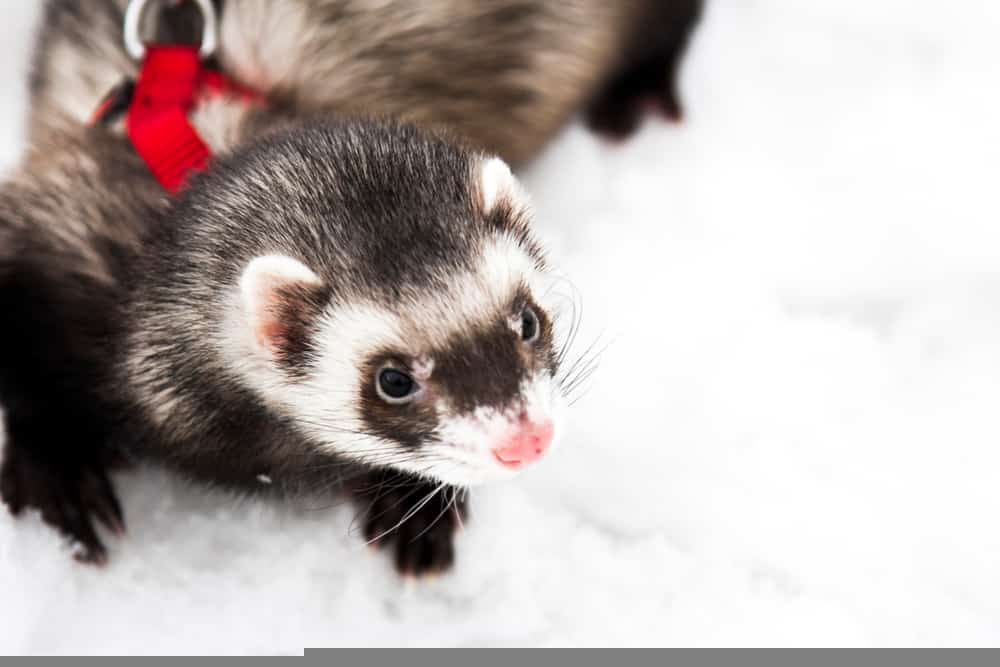
Here’s a look at some of the most frequently asked questions when it comes to ferret harnesses.
Do Ferrets Need to Go Outside?
Unlike dogs, most ferrets are trained or accustomed to relieving themselves inside the house, so in that sense, ferrets don’t need to go outside. But they are animals, and most animals are drawn to the outdoors.
While you should never let your ferret run outside without supervision, or being tethered by a leash or lead, most ferrets would probably enjoy some outdoor time. After all, these are curious critters, and the inside of their room or cage could bore them before long.
What Temperatures Are Unsafe for My Ferret to Be Outside?
Ferrets are quite sensitive to extreme temperatures, but they generally are more tolerant of cold than heat. Temperatures over about 78-80° can be uncomfortable or even dangerous for a ferret. These furry critters don’t have sweat glands, so once they get hot, it’s hard for them to cool down.
On the other end of the thermometer, most ferrets love cold weather and even snow, especially if it’s deep enough for them to tunnel and chase each other through. For those whose ferrets are normally housed indoors, remember that these ferrets will have thinner undercoats because they live primarily inside. So be sure to keep a close eye on how much snow romping they’re allowed, and if you see signs of shivering, bring them inside right away.
If you live in a climate where it’s regularly near the high end of the range of safe temperatures, it’s probably best to consider an H-style harness, which won’t have additional fabric, or be sure to find a vest harness that has lightweight, breathable fabric. This one and this one are great vest options for those who are concerned about overheating.
How Much Exercise Do Ferrets Need?
For ferrets, exercise is more about stimulation and enrichment than weight, though less-active ferrets can become overweight. According to the American Ferret Association Education Committee, ferrets need at least four hours per day of time outside their cage (more is better, of course), and at least two of the four hours should include human interaction.
Most ferret owners have various methods of entertaining and stimulating their ferrets, including tunnel-type toys, while others may rely on decidedly more low-tech methods like spare boxes.
Check out this resource for some more creative ways of adding enrichment to your ferrets’ lives.
Do All Ferrets Like to Go on Walks?
Definitely not. If you’ve tried and failed to get your ferret used to a harness and/or a leash, your dream of walking your ferret down the street is probably not meant to be. If you’re trying to train or walk your ferret, and they simply refuse to move, that’s a sign they aren’t enjoying the activity.
And some ferrets may grow to like walks more as they age, so don’t be afraid to keep trying. Just pay attention to your ferret’s physical and emotional signals, and let those guide you.
How Do You Put a Harness on a Ferret?
Very carefully. Kidding aside, all ferret harnesses, or harnesses that can be used for ferrets, come with detailed instructions about putting the harness on and ensuring it’s properly fitted. Be sure to follow these closely to ensure your ferret can’t wriggle their way out while you’re strolling down the street.
Can I Use a Cat Harness for My Ferret?
If it fits your ferret well and allows a leash to be attached to the back rather than the underside of the neck, a cat harness or even a small dog harness could be appropriate. Few products are made exclusively for ferrets, but that doesn’t mean they won’t work just as well or maybe better for your situation.
Should I Make My Own Ferret Harness?
There are a couple of methods for making your own ferret harness. (This one, in particular, is pretty tried-and-true.) As long as you’ve done your proper preparation to make sure that your ferret is comfortable walking in the harness and that they can’t escape from it, this could be a great option. Many ferret owners may be inclined to make their own harness so they can extend their own creativity to that area.
That’s not tough to understand since most ferret harnesses aren’t exactly pretty. But there are some options that could give you second thoughts about making your own, whether you’re into traditional styles or something more otherworldly.
Final Thoughts
Humans and ferrets have a long history together, but these crafty creatures are still considered exotic pets. To be fair, even among exotic pets, ferrets are quite rare. Nearly three times as many households are home to rabbits compared to ferrets. Given the niche popularity of ferrets, it can be quite a challenge to find products that work well, but hopefully, you can reduce your guesswork.



